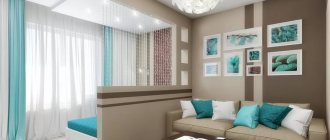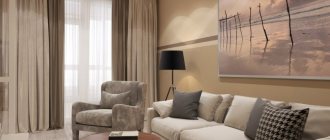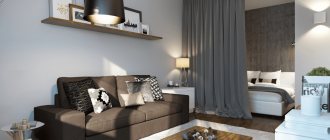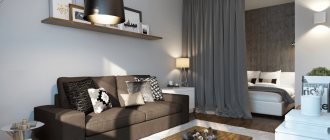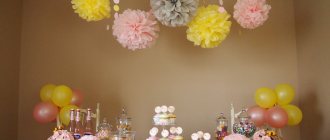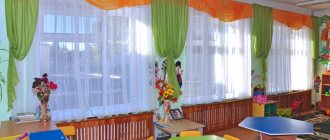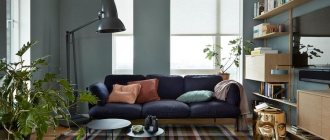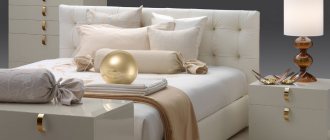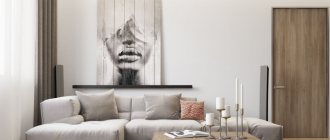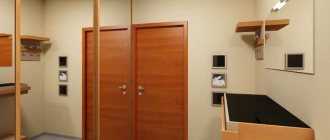Often young families live in one-room apartments. When a baby is born, it becomes necessary to arrange his sleeping place. But the size of the “odnushka” limits any design ideas. How to find a way out?
The design is developed in such a way that children and parents receive comfortable conditions for living together
But there is a way out. Read this review and learn how to make a children's corner in a one-room apartment and at the same time leave free space for yourself. At the end of the article there is a selection of suitable photographs.
Choosing a corner design
Consider the design of a corner for a girl and a boy.
While the child is small, you can get by with a hanging cradle next to the parents’ bed
For boy
For boys, blue is suitable. Finish the wall next to the bed with this shade. Additionally, arrange a pattern in the form of a tree with birds sitting on its branches. Small wall lights will fit perfectly.
Compact and versatile furniture will successfully replace a children's room
Buy a white bed. Multi-colored bed linen will add exclusive shades to every day. Choose pillowcases and sheets with your child. Various children's motifs, fairy tales, superheroes are a great idea.
Original shelves in the staircase corner for a teenage boy
Choose a light-colored wardrobe. It is better to purchase a set of:
- beds;
- cabinet;
- armchairs or chairs.
Take a look at the children's rug. Embroidering patterns of animals, compositions, frames from children's cartoons on the carpet will lift your child's spirits.
Cozy corner with a pull-out bed for a school-age boy
Don't forget to install a bookcase and study table. There are many options for children's wardrobes. One of them is shown in the photo of a studio apartment with an unusual crib and a place to store books. The cabinet is made in the form of wood. This is achieved by interior decoration of book shelves.
This design of a children's corner can be easily done independently from sheet material.
Give preference to natural materials. Wooden parquet, plasterboard niches, water-based paint. Do not use linoleum, cheap chipboard/fibreboard, or highly toxic paint for walls or ceilings.
Compact workplace for schoolchildren with a folding tabletop
For girl
Create a fabulous place. The ceiling is made two-level. Spotlights along the perimeter will add illumination in the evening. A sliding arched door is used for demarcation. The guides are installed in an arc.
A fairytale corner for a little princess
The bed is combined with wall shelves. In the niche, the wall is decorated with fabulous animals. For flooring, choose parquet or parquet boards. A laminate made to look like natural wood is suitable. Do not use ceramic tiles. Its surface is cold, the child will catch a cold.
Compact corner for comfortable placement of two girls of different ages
Curtain the window opening with a full curtain consisting of:
- curtains;
- porters;
- lambrequin.
Avoid using too thick sides in a room with poor natural light.
The color scheme for curtains is as follows:
- pink;
- lilac;
- peach;
- beige;
- light coffee.
If there is not enough space in the room, buy a bed in the second tier. Set up a desk under the bed for the girl to do her homework. Pay attention to lighting. The more light sources (lamps, sconces, floor lamps), the better for the child to study.
Comfortable loft bed for a school-age girl
How to choose the right place in the room?
A place for a child in a common room is usually organized using zoning.
When choosing a location, you need to consider several factors. Here are the most basic ones:
- Good lighting.
- The place should be ventilated periodically. It is advisable to use a climate complex that will not only provide the room with clean air, but also humidify it.
- Safety of the place for the child, taking into account his stay without adult supervision.
Tip: you can zone the area using bright wallpaper and functional furniture.
The color of the wallpaper can either match the interior of the common room or differ from it if the child wants a separate space that is different from the common room. The division of a room can be organized using a rack, whatnot, curtains, furniture or drywall.
It must be remembered that folding furniture, transformable beds and loft beds, folding tables, shelves are all indispensable items for optimizing space and solving a number of functional problems.
Lighting
The children's room should be well lit. Use different lamps. Suitable:
- ceiling chandeliers;
- wall sconces;
- floor lamps;
- LED strips;
- Spotlights;
- decorative lighting.
It is better to place a desk for a schoolchild closer to the window of the room
The LED strip is installed in niches. It looks good to arrange a “heavenly” ceiling, which is illuminated with a ribbon along the edge. An interesting option is to install lighting inside a cabinet with a mirrored door.
Hidden lighting looks original, creating the impression of a “floating” ceiling
For very young children, you need to consider night lighting
Spotlights are installed on the ceiling, in decorative wall niches, above the desk. Buy a table lamp with a regular incandescent light bulb. It is needed for the child's homework. Warm light from an incandescent light bulb is the most favorable source of lighting for the eyes. Children's pediatricians advise using just such lamps.
With the help of properly hung lamps you can highlight one or another area of the common room
Decorative lighting complements the interior of the space. If the wall depicts patterns, fairy tale characters, or other drawings, installing decorative lamps will transform the design. Wall shelves filled with figurines of animals, on which the light of the lamp falls from below, will look beautiful. At night, with the help of such elements you will see wonderful patterns on the ceiling.
Decorative clouds with built-in lighting look no less attractive
DIY design according to Federal State Educational Standards + photo
The safety of children is the most important task for parents, educators and all adults who surround them. Unfortunately, there are a lot of dangers in the world around us that can cause harm. Therefore, it is necessary not only to intensively protect and protect the child, but also to teach him safe behavior in various situations both in the house and outside it. This work is purposefully carried out in all educational institutions, starting from a young age in kindergarten and gives positive results. Because despite the complexity of the organization of modern society, childhood injuries are an emergency situation for which all those responsible bear responsibility.
Safety training in kindergarten
Teaching children not to get into dangerous situations both at home and in the outside world is the most important task for parents and educators in child care institutions. It is necessary to teach children safe behavior from the very first steps of life. There are a large number of situations when a child can get injured at home, on a walk, while playing, or while traveling in public transport. The main task of adults is not only to ensure control over the behavior of children, but also to instill in them the concept of their own safety . a safe behavior corner in kindergarten is intended to solve this problem. Using stands, models, toys, and didactic games, educators teach preschoolers the rules of behavior in the most likely life situations. The materials presented at the stands are also addressed to parents, since the child is with them most of the time, and young parents cannot always properly create a safe environment at home.
Table: studying the rules of life safety in different age groups of kindergarten
Design of a safety corner
The importance of the safety corner in the educational activities of teachers is quite great. But in order to successfully and efficiently teach children the basics of safety, it is necessary to have interesting and varied material in this area of work. The life safety corner may contain:
- Stands with information for parents about possible traumatic situations.
- Analytical reports on emergency incidents involving children.
- Visual materials for teaching safe behavior for children and adults.
- Didactic games (“Road Signs”, “Good and Evil Fire”, “Smart Traffic Light”, “Safety Fundamentals” and so on) factory-made and hand-made.
- Models of fire equipment, ambulance, fire shield - to better familiarize children with emergency services.
- Models of items for personal safety: reflectors, fire detector, fire extinguisher, emergency telephone numbers.
- Toys for organizing role-playing games: firefighter dolls, rescuers, policemen; children's equipment for traffic police and rescue service workers.
- Floor covering for designing traffic when studying traffic rules.
As part of the subject-development environment of the kindergarten, the safety corner must meet the requirements: aesthetic and attractive design for children and parents, functionality and variability, periodic updating of the content to maintain interest in the material.
Photo: Examples of organizing a children's area in a one-room apartment
The importance of a developing subject-spatial environment in the senior group of preschool educational institutions
The task of any preschool educational institution (DOU) is to create conditions for the development and upbringing of children, maintaining their health in a safe and comfortable environment. The most important component of this task is the organization of a subject-spatial environment that corresponds to the components of the educational and developmental process carried out by teachers. It has long been proven that a child’s development occurs with his active participation in a variety of activities. For senior group students, the following areas are highlighted:
- training and development activities;
- performing practical and creative work;
- role-playing games;
- basics of labor activity;
- physical education classes;
- music and choreography lessons.
The administration of a children's educational institution, teachers and educators must create a multi-component educational environment for a preschooler, which takes into account different aspects of organizing the process of raising and developing a child. This:
- developing subject-spatial environment;
- organizing interaction with teachers;
- communication with peers;
- the preschooler's attitude to the world around him and to himself.
Children should live in a world of beauty, games, fairy tales, music, drawing, fantasy, and creativity.
V. A. Sukhomlinsky
Principles of constructing a subject-development environment
The subject-spatial environment in the older group serves the development of children's activities, primarily play. Indeed, during play, the leading activity of preschool children, cognitive motivation develops, which is the basis of educational activity. The subject-spatial developmental environment must correspond to the zone of proximal mental development of a 5-6 year old child - the formation of prerequisites for educational activity.
Zoning
The correct and successful interior of a small children's room must be divided into zones. Each zone has its own purpose.
- Storage space.
- Game Zone.
- Study area.
- A place to relax.
Each zone should be easy to use, it should correspond to its purpose and be clearly defined. It is not recommended to use screens and partitions, as this will make the space even smaller.
The zones should not contrast with each other; for this it is recommended to adhere to a single style. You should not use more than three colors in the design, otherwise it may irritate the child’s nervous system.
Rack for sports equipment
Decorating a sports corner with your own hands is done in the active games area. For bright hoops, clubs, balls and jumping ropes, it is necessary to organize aesthetic and convenient storage with special holders, nets and shelves.
To equip the corner, you need to use the safest plastic or fabric products.
The contents of the exhibition can be supplemented with homemade items, such as fake fishing rods or other devices for developing dexterity.
